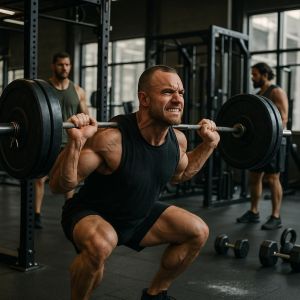The Benefits of Using Steroids for Muscle Recovery
In the world of athletic prowess and everyday fitness, muscle recovery stands as a cornerstone of success. For athletes, bodybuilders, and casual gym-goers alike, the speed and efficiency of bouncing back from grueling workouts directly influence performance, stamina, and long-term progress. However, muscle fatigue, soreness, and extended recovery periods often pose formidable barriers, stalling many from reaching their full potential.
This struggle has sparked a quest for effective recovery solutions, with steroids emerging as a powerful yet polarizing option. Despite their controversial reputation in mainstream media, the top steroids benefits for muscle recovery are undeniable, offering accelerated repair, reduced inflammation, and a lifeline for those battling chronic exhaustion or training plateaus. But with great power comes great responsibility: understanding how steroids work, weighing their advantages against their risks, and navigating their legal and ethical landscape are critical for anyone considering their use.
In this comprehensive guide, we’ll unpack what steroids are, spotlight their standout benefits for muscle recovery, dive into the science backing their efficacy, address the potential downsides and health risks, and explore the legal and moral considerations tied to their use. By the end, you’ll have a balanced, informed perspective to decide if steroids fit into your fitness journey responsibly.
Top Steroids Benefits for Muscle Recovery
One of the top steroids benefits for muscle recovery is their remarkable ability to slash inflammation and soothe post-workout pain. Intense exercise tears muscle fibers on a microscopic level, triggering inflammation as the body rushes to repair itself. This natural response, while necessary, often leaves athletes sidelined with soreness and stiffness. Steroids step in with potent anti-inflammatory properties, dialing down this swelling and easing discomfort. The result? Faster recovery, less downtime, and a quicker return to the gym key for maintaining a steady training rhythm.
Another game-changing perk is how steroids supercharge protein synthesis, the body’s process of rebuilding damaged muscle tissue. After a tough session, muscles rely on proteins to mend tears and grow stronger. Steroids amplify this by boosting nitrogen retention and funneling amino acids the building blocks of protein directly into muscle cells. This accelerated repair not only speeds recovery but also fortifies muscles against future strain, helping athletes push harder without breaking down.
Beyond repair, steroids act as a shield against muscle wasting, a common pitfall during recovery. When the body rests or heals from injury, it can slip into a catabolic state, breaking down muscle for energy. Steroids counter this by preserving muscle mass, ensuring hard-earned gains stay intact even during off-days or setbacks. This protective effect is a lifeline for those recovering from overtraining or injuries, keeping progress on track.
Endurance and energy also get a major lift, making steroids a stamina powerhouse. Post-workout fatigue can linger, draining motivation and cutting sessions short. Steroids bolster glycogen storage in muscles an energy reserve that fuels longer, more intense workouts. With this boost, athletes can train at peak levels without crashing, breaking through fatigue walls that once held them back. It’s a cycle of resilience: better recovery fuels better performance, which in turn demands even stronger recovery.
-
- Reduction in inflammation and pain post-workout
-
- Enhanced protein synthesis for expedited muscle repair
-
- Prevention of muscle wasting during recovery periods
-
- Increased endurance and energy levels
These benefits paint steroids as a compelling tool for optimizing muscle recovery, especially for those chasing ambitious fitness goals. Yet, their power isn’t without pitfalls. To wield them effectively, users must pair these advantages with a clear-eyed look at the risks a balance we’ll explore next.
Scientific Backing and Studies
Insight From Research
Science has long probed the top steroids benefits for muscle recovery, yielding insights that bolster their reputation. A landmark study in the *Journal of Clinical Endocrinology & Metabolism* found that anabolic steroids significantly ramp up protein synthesis in muscle tissue. This boost speeds repair and growth after intense exercise, a boon for athletes aiming to shrink recovery windows. By enabling quicker turnarounds, steroids help maintain rigorous schedules without the drag of lingering fatigue.
Another study, published in the *American Journal of Physiology*, zeroed in on inflammation. Researchers observed that steroids slash inflammatory markers like IL-6 and CRP post-workout. This reduction not only dulls pain but also curbs tissue damage from prolonged swelling, creating a healthier recovery zone. For those pushing their bodies to the limit, this anti-inflammatory edge can mean the difference between thriving and burning out.
These findings aren’t isolated. A 2018 review in *Sports Medicine* synthesized data from multiple trials, confirming steroids’ role in enhancing recovery metrics less soreness, faster strength regain, and improved muscle integrity. While not a green light for unchecked use, this research underscores why steroids hold appeal for recovery-focused fitness buffs.
Mechanisms of Action
To grasp steroids’ recovery magic, we need to peek under the hood at their cellular wizardry. Anabolic steroids latch onto receptors in muscle cells, sparking a chain reaction of growth and repair. They crank up nitrogen retention a marker of anabolic activity keeping muscles in a protein-building state. This primes the repair process, ensuring new tissue forms fast and strong.
Satellite cells, the unsung heroes of muscle regeneration, also get a boost. Steroids rev up their activity, prompting these cells to multiply and fuse with damaged fibers, bulking up muscle mass. This dual action nitrogen balance and satellite cell proliferation lays the groundwork for rapid recovery and hypertrophy, the holy grail for strength seekers.
Hormones play a starring role too. Steroids elevate IGF-1 (Insulin-like Growth Factor 1), a key player in muscle development. Higher IGF-1 levels turbocharge amino acid uptake, fueling protein synthesis, and drive satellite cells to mature into full-fledged muscle fibers. This hormonal shift creates a recovery ecosystem where muscles heal faster and emerge more resilient a cycle that keeps athletes in the game.
Together, these mechanisms explain steroids’ prowess in cutting recovery time and boosting performance. But science also flags caution: these benefits hinge on proper use, not abuse a line we’ll cross into next.
Potential Risks and Side Effects
While the top steroids benefits for muscle recovery shine bright, their shadow side looms large. Short-term risks hit fast and hard think mood swings dubbed “roid rage,” where users grapple with aggression or irritability. Hormonal shifts can also trigger acne, oily skin, or gynecomastia (breast tissue growth in men), turning a quest for gains into a cosmetic headache.
Long-term use ups the ante. Chronic steroid abuse is tied to heart disease think heart attacks or strokes driven by spiked cholesterol and blood pressure. Kidneys and livers aren’t spared either, with risks of damage, tumors, or failure climbing over time. Blood clots, another silent threat, can wreak havoc if ignored.
Dependency is a subtler snare. Once hooked, stopping steroids can feel like pulling the plug on progress psychologically and physically. Muscles may shrink, energy crash, and motivation tank, trapping users in a cycle tough to break. Medical oversight is non-negotiable here, guiding doses and breaks to dodge these traps.
| Short-Term Side Effects | Long-Term Side Effects |
|---|---|
| Mood Swings (Roid Rage) | Cardiovascular Diseases |
| Acne | Liver Tumors |
| Gynecomastia | Kidney Damage/Failure |
| Hormonal Imbalance | Increased Risk of Blood Clots |
Real-world cases hammer this home. Take a bodybuilder who chased gains with reckless dosing initially, he swelled with muscle, but unchecked use led to kidney failure. Another athlete ignored cycle limits, landing with irreversible liver damage. These cautionary tales spotlight the stakes: steroids demand respect, not blind ambition. Medical pros can spot early warning signs hormone spikes, organ stress keeping risks in check with smart management.
The takeaway? Steroids’ recovery perks come with a cost. Weighing them means embracing moderation, regular check-ups, and a willingness to pivot if the body signals trouble.
Legal and Ethical Considerations
Steroids’ legal landscape is a patchwork quilt knowing your spot on it is crucial. In many countries, anabolic steroids are controlled substances, locked behind prescriptions. Canada, for instance, classifies them under the Controlled Drugs and Substances Act possession without a doctor’s note can mean fines or jail. Other nations wield harsher penalties, making illegal steroid use a gamble not worth taking.
For pros, the stakes soar higher. The World Anti-Doping Agency (WADA) bans steroids in competitive sports, with violations triggering suspensions or ruined careers. Even a whiff of use can tarnish reputations, as seen in high-profile doping scandals. Athletes must sync their recovery goals with these ironclad rules or risk losing it all.
Ethics add another layer. Steroids tilt the playing field, giving users a leg up over peers who grind it out naturally. This sparks debate: is it fair? In pro circles, it’s a clear no rules exist for a reason. But even casual gym rats face judgment friends or rivals may see steroid gains as “cheating,” not grit. It’s a personal call, but one that ripples outward.
For those dodging legal or moral quagmires, alternatives beckon. Optimized diets think protein-packed meals pair with rest and supplements like creatine or BCAAs to mimic some steroid perks sans the baggage. These paths take longer but sidestep the risks, offering a cleaner shot at recovery.
Steroids for muscle recovery are a double-edged sword potent yet perilous. Their top benefits slashing inflammation, turbocharging protein synthesis, guarding against muscle loss, and pumping up endurance make them a siren call for athletes and fitness fans battling fatigue or plateaus. Quicker recovery translates to more consistent training, a lifeline for pushing limits.
But the flip side looms large. Short-term hiccups like mood swings or acne can escalate into heart issues, organ damage, or dependency if misused. Legal hurdles and ethical debates further muddy the waters breaking laws or norms can cost more than gains are worth. It’s a tightrope walk, demanding medical guidance to stay steady.








